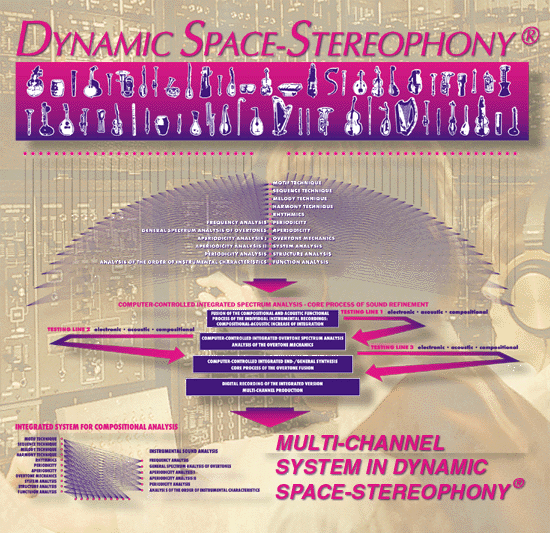In his book, Natural Music Creation,
the classical composer Peter Hübner writes that the composer experiences
the music in his inner being as a dynamic spatial-temporal process of development:
The musical elements – the sounds, the motifs, the melodies and the sequences
– unfold both temporally and, in accordance with the laws of musical
logic, spatially – and this is testified too by the statements of our
great classical composers.
The conventional performance style with its sounding “orchestra-apparatus”
fixed in space has not so far done justice to this truth of the spatial-temporal
development of the music in the consciousness of the composer. The reason
for this failure is due to the fact that the conventional performance practice
has hitherto restricted itself to presenting in the acoustical realm –
in regard to the spatial-temporal development – merely the seating arrangement
of the orchestra: a fact, which is not even designated in the score, since
it does not attach any musical significance worth mentioning to the classical
composer.
Thus, it is not even surprising when confined to the conventional static performance
style the conductor and the musician eventually reach for new inappropriate
means of communicating the musical content, as, for example, the mimicking
display of feelings through gesticulation or the optical display of musical
instruments.
Nevertheless, these sorts of optical manipulations do not prove to be intrinsically
musical or adequate means to introduce the deep meaningfulness of the music
to the hearer, who is constrained to assume the roll of an onlooker by these
optical manoeuvres.
A real attempt to do justice to the personal musical evidence can only be
to bring the music to performance in an authentic way. It is the musical statement
that must be revealed to the hearer with musical-technical means, pure and
unadulterated – and not the seating arrangement for the musicians, or
even the mimicking and gesticulating of the conductor.
The latter is actually a modern phenomenon – and not only in word but
also in the actual operations of his Festival Performance Hall in Bayreuth
Richard Wagner for instance let this whole gesticulating apparatus disappear
from the sight of the visitor in favour of the most unadulterated musical
expression possible.
The Dynamic Space-Stereophony represents a fully new musical and technical
system, both for recording and performance. By the help of the Dynamic Space-Stereophony
the music is performed directly in the outer acoustical space in the very
same way as it unfolds according to musical laws spatially in the consciousness
of the classical composer – thus making this spatial unfoldment of the
music clearly perceptible for every listener.
If in comparison with visual representations the acoustical worth of the conventional
style of performance corresponds to a fixed picture, whose single components
are illuminated in succession but are nevertheless motionlessly fixed, than
the Dynamic Space Stereophonycorresponds in its multi-channel end version
to the system of the controlled moving holography.
Today the development of the Dynamic Space-Stereophony provides us for the
first time in the known history of music with the possibility to project music
audible for everyone into the outer acoustic space in its original purity
and, according to musical logic, in a dynamic musical spatial-temporal development.
According to the present state of knowledge, this recording and performance
technique of Dynamic Space-Stereophony represents the technical perfection
of musical “interpretation.” What more would the music interpreter
desire to perform than that which develops audibly and dynamically in the
composer’s realm of musical imagination?
And how differently would the interpreter like to represent it than as it
dynamically developed?
The function of this special music hall is to bring to performance the works
of the classical composer Peter Hübner in Dynamic Space-Stereophony, and
in so doing, to reveal a new electrifying musical experience to the listener
of our modern age.
© A A R E D I T I O N I N T E R N A T I O N A L 2000

Dynamic Space Stereophony®
| Site Map |
| Editorial |
| R & D |
| Dynamic
Space Stereophony® |
| Principle, Experts |
| Modern
Music Technologies |
| Music |
| Peter Hübner |
| International Experts |
| International Media |
| Asian Media |
| Main Links |
| STORE |